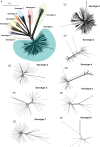Sequence analysis of the hepatitis D virus across genotypes reveals highly conserved regions amidst evidence of recombination
- PMID: 40123834
- PMCID: PMC11927530
- DOI: 10.1093/ve/veaf012
Sequence analysis of the hepatitis D virus across genotypes reveals highly conserved regions amidst evidence of recombination
Abstract
Sequence diversity of the hepatitis D virus (HDV) may impact viral clearance, contributing to the development of chronic infection. T-Cell-induced selection pressure and viral recombination can induce diversity throughout the viral genome including coding and noncoding regions, with the former potentially impacting viral pathogenicity and the latter exerting regulatory functions. Here, we aim to assess sequence variations of the HDV genome within and across HDV genotypes. Sequences from 721 complete HDV genomes and 793 large hepatitis D antigen (L-HDAg) regions belonging to all eight genotypes and published through December 2023 were compiled. Most retrieved sequences belonged to Genotype 1, whereas for Genotype 8, the fewest sequences were available. Alignments were conducted using Clustal Omega and Multiple Alignment using Fast Fourier Transform. Phylogeny was analysed using SplitsTree4, and recombination sites were inspected using Recombination Detection Program 4. All reported sequences were aligned per genotype to retrieve consensus and reference sequences based on the highest similarity to consensus per genotype. L-HDAg alignments of the proposed reference sequences showed that not only conserved but also highly variable positions exist, which was also reflected in the epitope variability across HDV genotypes. Importantly, in silico binding prediction analysis showed that CD8+ T-cell epitopes mapped for Genotype 1 may not bind to major histocompatibility complex class I when examining their corresponding sequence in other genotypes. Phylogenetic analysis showed evidence of recombinant genomes within each individual genotype as well as between two different HDV genotypes, enabling the identification of common recombination sites. The identification of conserved regions within the L-HDAg allows their exploitation for genotype-independent diagnostic and therapeutic strategies, while the harmonized use of the proposed reference sequences may facilitate efforts to achieve HDV control.
Keywords: epitopes; genotypes; hepatitis D virus; recombination; reference sequences.
© The Author(s) 2025. Published by Oxford University Press.
Conflict of interest statement
S.C., C.J., D.P.D. and H.K. declare no conflicts of interest. H.W. has research grants from Abbott and Biotest, is on the speakers’ bureau for Biotest and Gilead, and is on the consulting or advisory board for Abbott, Bristol-Myers-Squibb, F. Hoffmann-La Roche, Gilead, GlaxoSmithKline, Janssen, Roche, and Vir Biotechnology. L.S. reports lecture honoraria and personal fees from Falk Pharma e.V., Gilead, and Roche and travel support from AbbVie and Gilead.
Figures






References
-
- Brown DW. Threat to humans from virus infections of non‐human primates. Rev Med Virol 1997;7:239–46. - PubMed
-
- Chao M, Wang T-C, Lin -C-C et al. Analyses of a whole-genome inter-clade recombination map of hepatitis delta virus suggest a host polymerase-driven and viral RNA structure-promoted template-switching mechanism for viral RNA recombination. Oncotarget 2017;8:60841–59. doi: 10.18632/oncotarget.18339 - DOI - PMC - PubMed
LinkOut - more resources
Full Text Sources
Research Materials

